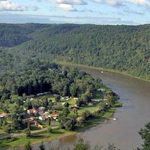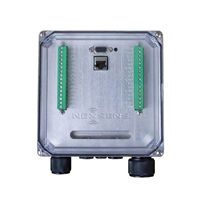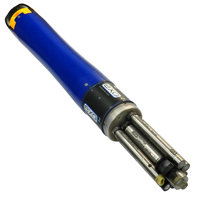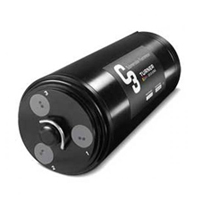
 Drinking water supplies in the United States are an extremely valuable national asset and are vital to our country’s survival. During the past few years, these resources have been thrust into the national spotlight as government agencies have placed an increased emphasis on their surveillance and protection.
Drinking water supplies in the United States are an extremely valuable national asset and are vital to our country’s survival. During the past few years, these resources have been thrust into the national spotlight as government agencies have placed an increased emphasis on their surveillance and protection.
Prompted by this initiative to monitor drinking water quality, the Ohio River Valley Water Sanitation Commission recently completed the design and implementation of an early warning detection and water quality monitoring system for the Allegheny and Monongahela rivers in Pennsylvania. These two rivers supply drinking water to approximately 1.3 million residents throughout western Pennsylvania and are critically important to the state’s wellbeing.
As the confluence of the Allegheny and Monongahela rivers creates the Ohio River, it was imperative that a system be developed that was capable of detecting and tracking any possible contamination in either of the two rivers that could affect drinking water. To achieve this, ORSANCO created a system that combines both human and automated efforts to establish effective water quality monitoring programs on the rivers.
These combined efforts resulted in the creation of the Allegheny and Monongahela Early Warning Detection System. AMEWDS utilizes a variety of water quality instrumentation installed in automatic monitoring stations at water utilities located along the two rivers. During planning meetings, many participants expressed a strong desire to access real-time water quality data from all monitoring sites over the Internet. This added component took the project to an entirely new level, enabling water utilities, researchers, and scientists to automate data collection and coordinate early warning detection efforts.
Operators at the various water facilities on the Allegheny and Monongahela rivers are automatically notified of any possible contamination event as soon as it occurs on either river. This automation is supported by NexSens Technology’s real-time environmental monitoring systems consisting of 2100-iSIC Data Loggers and PCs running popular iChart software.
An invaluable monitoring tool
 NexSens 2100-iSIC phone modem data loggers were installed at each water utility plant and serve as a remote data collection unit and sensor communication hub, capable of recording measurements from sensing devices and transmitting them back to operators for further analysis. This NexSens data logger’s ability to integrate diverse sensors from different manufacturers into one system was an important objective and the reason ORSANCO selected NexSens Technology.
NexSens 2100-iSIC phone modem data loggers were installed at each water utility plant and serve as a remote data collection unit and sensor communication hub, capable of recording measurements from sensing devices and transmitting them back to operators for further analysis. This NexSens data logger’s ability to integrate diverse sensors from different manufacturers into one system was an important objective and the reason ORSANCO selected NexSens Technology.
Each 2100-iSIC data logger installed onsite contains an integrated landline modem that enables ORSANCO to manually dial in through standard telephone lines and retrieve river water quality data even in the case of a complete computer failure. The data logger is compatible with many popular water quality, water level, and meteorological sensors. Options are available for both solar and AC power, as well as wireless telemetry via spread spectrum radio or cellular telemetry.
All automated data processing is performed by PCs running NexSens iChart software at each water utility. Scheduled data downloads provide users with a real-time picture of river water quality conditions by displaying the information on screen. The system also notifies operators whenever a change in water quality occurs by triggering a software alarm that sends a message to pagers. Multiple users can receive this notification and coordinate their cleanup and tracking programs with increased effectiveness.
iChart software works with WQData, a web-based, graphical user interface that provides water plant operators access to environmental data collected at monitoring sites. Operators use the datacenter to view current sensor readings and generate customized data reports.
All data is accessible via any standard web browser. A map displays the location of each water utility as well as real-time data updates from each site. The web interface automatically detects the type of sensors and parameters deployed at each location. Operators can download their data to a PC for further analysis or view it quickly through a web browser.
YSI multi-parameter sondes were installed at seven sites along the rivers and provide continuous monitoring of water temperature, conductivity, dissolved oxygen, pH, turbidity, and chlorophyll. The instruments are designed for long-term, unattended monitoring, and individual probes can be configured with integral wipers, keeping them clean in high fouling environments. Operators use the sondes to watch for changes in water quality conditions that may indicate an event such as a spill, leak, or contamination has occurred.
Other products installed were Turner Designs fluorometers and ISCO online TOC analyzers. The fluorometers analyze the hydrocarbons present in water samples collected from the rivers. Operators use the information obtained from the instruments to monitor the overall health of the environment. The data from the on-line TOC analyzers is transmitted remotely by a NexSens telemetry system and can be accessed in real-time on the Internet. With access to real-time TOC data, operators can continuously monitor for any change in organic material present in the rivers.
The AMEWDS system remains an invaluable tool that continues to protect drinking water resources in western Pennsylvania. The combination of multiple sensor and communication technologies with a simplified user interface and data sharing over the Internet has provided water facility operators with one of the most advanced water monitoring systems in the nation.
The NexSens iSIC V2 Environmental Data Logger offers the latest in real-time monitoring technology with wireless communication, large plug-and-play sensor library, and ultra-low power consumption.
The YSI EXO represents the next generation of water quality instruments from YSI. The EXO2 sonde includes six sensor ports and a central anti-fouling wiper option.
The Turner Designs C3 Submersible Fluorometer is designed to incorporate up to three optical sensors ranging from the ultraviolet to the infrared spectrum.
WQData LIVE is a web-based project management service that allows users 24/7 instant access to data collected from remote telemetry systems.




